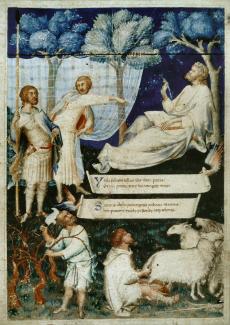(B2-19) Between Religious Piety and Political Reflection: The Cognitive Function of Narrative and Allegorical Representations in Trecento Texts (Dante, Petrarca, Boccaccio)
The project focusing on 13th-century Italy builds on the perspective of the first field of research of the Cluster, “Authorship”, and extends the subject-oriented problem to the representations of space.
A particular space as a place of solitude and as a stage for the author’s self-representation will become the focus of the analysis’ attention: the countryside. Alongside the urban and monastic space, the “countryside” as an object of literature and as a depicted space became significantly more important in literature extending from the Middle Ages to the Renaissance. Poetry develops in the countryside as a place of inspiration, poet’s characters move through and linger in places in the countryside. Here, the pastoral, rural space is at conflict both with the socio-political areas of the town and with religious allegorical places. As long as nature is to be thought as divinely structured and every element of creation is interpreted (allegorically) as part of an all-encompassing salvific historical order, a non-perceptive subjectivity organises paintings or literary representations. In fact, every element of nature refers to the divine Creator, thus taking its place within a theological order. The readability of nature as divine creation leaves no room for a subjective interpretation of the countryside. The countryside forms part of man’s subjective horizon of experience; its interpretation is accompanied by an illustrating and interpreting perception and representation pointing to the inventio and the imaginatio of man. In this respect, the countryside is a place and a medium of fiction par excellence. According to what modern literary theory agrees on, literary texts have – in contrast to theological or legal texts – an additional value which transcends the propositional or referential context and may be defined by the term of fictionality. What is the additional value of countryside fiction? Fictional countryside spaces situate themselves in most cases adversatively or in a critical function towards existing social, political and legal spaces of the town. They expand and modify valid norms and traditions. One example of this is the limbo’s locus amoenus as the residence of the ancient poets and as the space of the (secret) discussion of Dante and Vergil. Another is Boccaccio’s Decameron, which opens the countryside place as a room of narration and critique of social (religious and legal) norms. Starting from a research focus of the project head, the functions of the countryside with Petrarch, primarily in Canzoniere, will be investigated. An assistant’s research project on the outlined problem will be the object of a dissertation.

The very beautiful, famous frontispiece of Petrarch’s Virgil was made by Simone Martini and shows Virgil commentator Servius lift a veil that roughly marks the middle of the picture. In an emphatic gesture, Servius is pointing his finger at Virgil, who is sitting under a tree, leaning against the trunk. The poet is wearing a white garment that also covers the legs and feet, and he is sitting directly at the threshold of the green here and now and the blue netherworld. This frontier is also marked vertically by means of the schematisedly painted row of three trees. Virgil’s gestures, his hand holding a feather pointing to the firmament, are also emphasised. The heavy area in the space on the other side of the veil and the scrolls held by two wings in the here-and-now green refer to language and writing. The three other figures are personifications of the three great works of Virgil: Aeneid, the Georgics and the Eclogues. Typologically, the figures illustrate social status and activity performed and, thus, at the same time the three different styles. The depicted space is not (yet) a countryside space. The illustration shows the power of poetry as regards the formation of structure and the development of standards, which builds a vertically aligned space and also categorises the human environment into types.

